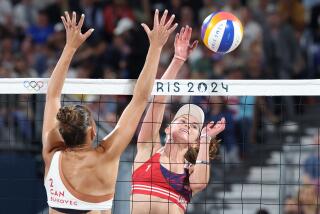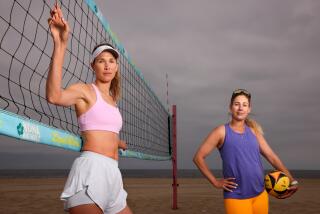This Tall Tale Is Going Strong
- Share via
It was 2003, long before Phil Dalhausser had transformed into “the Thin Beast,” when Todd Rogers first saw his future volleyball partner.
“I wrote him off as a big dork from the East Coast,” Rogers said.
Rogers had the big part right. At 6 feet 9, Dalhausser is the second-tallest player on the AVP Pro Beach Volleyball Tour. He had the East Coast part right too. Dalhausser is from Ormond Beach, Fla.
The rest he was wrong about.
Dalhausser, whose background was limited to two years in high school and four years of pickup games in college, has steadily risen through the AVP rankings in the last three years. And this year, under the tutelage of Rogers, he has blossomed into one of the top big men in the beach game.
He leads the AVP with 125 blocks, is third with a .503 kill percentage and has teamed with Rogers for an AVP-best three victories. Suddenly, the “big dork” has become “the Thin Beast.”
“I actually was kind of a dork,” Dalhausser said. “Those first couple of tournaments I wouldn’t even go into the players’ tent because I felt like I didn’t belong in there. It’s different now.”
Many non-Westerners who end up on the tour have played for a Southern California college or are a product of the national indoor team. Dalhausser went to the University of Central Florida, which doesn’t compete in volleyball at the NCAA level.
He was a tennis player, but he found the transition to volleyball smooth because many of his skills -- serving to hitting, for example -- translated well.
“Everything came natural to me,” he said. “I became one of the better players pretty quick.”
He started playing in local beach tournaments, making a couple of hundred dollars a week, and decided he’d like to try to make that a career.
In 2003, he and fellow Floridian Nick Lucena gave the AVP a try, playing in five open qualifiers and making the main draw four times but finishing last in three of them.
They did, however, win an AVP Next tournament that allowed them entry into the main draw in the first four AVP tournaments of 2004.
They finished seventh in the first one and acquired enough points to stay exempt for the year. All the while, Dalhausser was attracting attention for his bald head and his devastating blocking ability.
“I got to know him a little bit, so I paid more attention to him as a player,” Rogers said. “And just watching him, you could see all his natural ability.”
Dalhausser and Lucena had a third-place finish at Hermosa Beach in 2004, got their first victory in Austin, Texas, last year, then backed that up with an appearance in the finals at Manhattan Beach later in the season.
After the 2005 season, nine of the top 10 men’s teams broke up and many of those players courted Dalhausser. That group included Rogers, even though he and Sean Scott had won the circuit’s last three tournaments.
“Ninety percent of the people said, ‘What are you doing?’ ” Rogers said of his breakup with Scott. “Nobody does that after winning three in a row. But I had to look at the big picture. When I saw Phil, I thought he could be one of the best in the world.”
Rogers, the two-time reigning AVP defensive player of the year, made the switch with the 2008 Olympics in mind. In international volleyball, it has become essential to have an imposing big man at the net and a skilled defender to chase down balls.
“I saw a ridiculous amount of talent that was untapped,” Rogers said. “But Phil had the gnarliest reputation as being lazy. I told him he needed to be prepared to work harder than he ever has: weight room, plyometrics, training every day.”
Dalhausser said playing with Rogers, a 12-year AVP veteran, has made a world of difference in his advancement as a player.
Rogers and Dalhausser finished ninth in the season opener this year but have since run off three consecutive victories.
Dalhausser has increased his season winnings from $780 in 2003 to $11,648 in 2004 and $61,288 last year. In only five tournaments this year, he has earned $59,225.
“When I first came out, my only goal was to just make enough money to get from tournament to tournament,” Dalhausser said. “Then it was to just make a living at it. Now I’m thinking about the Olympics. How crazy is that?”
More to Read
Go beyond the scoreboard
Get the latest on L.A.'s teams in the daily Sports Report newsletter.
You may occasionally receive promotional content from the Los Angeles Times.










